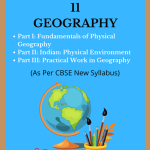NCERT Class 11 Geography Chapter 4 Distribution of Oceans and Continents Solutions to each chapter is provided in the list so that you can easily browse through different chapters NCERT Class 11 Geography Chapter 4 Distribution of Oceans and Continents and select need one. NCERT Class 11 Geography Chapter 4 Distribution of Oceans and Continents Question Answers Download PDF. NCERT Geography Class 11 Solutions.
NCERT Class 11 Geography Chapter 4 Distribution of Oceans and Continents
Also, you can read the NCERT book online in these sections Solutions by Expert Teachers as per Central Board of Secondary Education (CBSE) Book guidelines. CBSE Class 11 Geography Solutions are part of All Subject Solutions. Here we have given NCERT Class 11 Geography Part I: Fundamentals of Physical Geography, Part II: Indian: Physical Environment, Part III: Practical Work in Geography. NCERT Class 11 Geography Chapter 4 Distribution of Oceans and Continents Notes, NCERT Class 11 Geography Textbook Solutions for All Chapters, You can practice these here.
Distribution of Oceans and Continents
Chapter: 4
GEOGRAPY [ PART – I ]
TEXTUAL QUESTIONS ANSWERS
MULTIPLE CHOICE QUESTIONS
1. Who amongst the following was the first to consider the possibility of Europe, Africa and America having been located side by side.
(a) Alfred Wegener.
(b) Antonio Pellegrini.
(c) Abraham Ortelius.
(d) Edmond Hess.
Ans. (c) Abraham Ortelius.
2. Polar fleeing forces relate to:
(a) Revolution of the earth.
(b) Gravitation.
(c) Rotation of the earth.
(d) Tides.
Ans. (c) Rotation of the earth.
3. Which one of the following is not a minor plate?
(a) Nazca.
(b) Arabia.
(c) Philippines.
(d) Antarctica.
Ans. (d) Antarctica.
4. Which one of the following facts was not considered by those while discussing the concept of sea floor spreading.
(a) Volcanic activity along the mid-oceanic ridges.
(b) Stripes of normal and reverse magnetic field observed in rocks of ocean floor.
(c) Distribution of fossils in different continents.
(d) ‘Age of rocks from the ocean floor.
Ans. (c) Distribution of fossils in different continents.
5. Which one of the following is the type of plate boundary of the Indian plate along the Himalayan mountains?
(a) Ocean-continent convergence.
(b) Divergent boundary.
(c) Transform boundary.
(d) Continent-continent convergence.
Ans. (d) Continent-continent convergence.
6. What was the name given to the massive ocean by Wegener?
(a) Pangaea.
(b) Panthalassa.
(c) Angaraland.
(d) Gondwanaland.
Ans. (b) Panthalassa.
7. The continental drift theory was propounded by
(a) Alfred Wegner.
(b) Aortelius.
(c) Hall and Danna.
(d) Abraham Ortelius.
Ans. (a) Alfred Wegner.
8. The Indian subcontinent was located at
(a) 60 degree South latitude.
(b) 30 degree South latitude.
(c) 50 degree South latitude.
(d) 40 degree South latitude.
Ans. (c) 50 degree South latitude.
9. Which one of the following is not a minor plate?
(a) Nazca.
(b) Arabia.
(c) the Philippines.
(d) Antarctica.
Ans. (d) Antarctica.
10. When did Alfred Wegener give continental drift theory?
(a) 1920
(b) 1946
(c) 1912
(d) 1948
Ans. (c) 1912.
11. Which one of the following terms is related to Polar fleeing force?
(a) Revolution of the Earth.
(b) Gravitation.
(c) Rotation of the Earth.
(d) Tides.
Ans. (c) Rotation of the Earth.
12. What is a tectonic plate that lies between the Asiatic and Pacific Plate?
(a) Cocos Plate.
(b) Nazca Plate.
(c) Arabian Plate.
(d) Philippine Plate.
Ans. (d) Philippine Plate.
13. Who was the founder of convection currents theory?
(a) Arthur Holmes.
(b) McKenzie, Parker and Morgan.
(c) Admans Heinz.
(d) Alfred Wegener.
Ans. (a) Arthur Holmes.
14. A tectonic plate is a slab of
(a) molten rock.
(b) hot rock.
(c) solid rock.
(d) small rocks.
Ans. (c) solid rock.
15. According to the Plate Tectonic concept, how many major plates are there?
(a) Seven.
(b) Nine.
(c) Twelve.
(d) Eleven.
Ans. (a) Seven.
16. By which method has facilitated correlating the rock formation from different continents across oceans?
(a) The radiometric dating methods.
(b) Carbon 14 method.
(c) Radioactive methods.
(d) Fling method.
Ans. (a) The radiometric dating methods.
17. What was the name given by Alfred Wegener to a large continent surrounded?
(a) Pangaea.
(b) Panthalassa.
(c) Angaraland.
(d) Gondwanaland.
Ans. (a) Pangaea.
18. The ocean floor may be segmented into how much division based on the depth as well as the forms of relief?
(a) Three.
(b) Four.
(c) Five.
(d) Seven.
Ans. (a) Three.
19. Which one of the following is the type of plate boundary of the Indian plate along the Himalayan Mountains?
(a) Ocean-Continents convergence.
(b) Divergent boundary.
(c) Transform boundary.
(d) Continent convergence.
Ans. (d) Continent convergence.
20. Tillite is formed due to
(a) deposits on mountains.
(b) deposits of volcanoes.
(c) deposits of glaciers.
(d) deposits of gold.
Ans. (c) deposits of glaciers.

Hi! my Name is Parimal Roy. I have completed my Bachelor’s degree in Philosophy (B.A.) from Silapathar General College. Currently, I am working as an HR Manager at Dev Library. It is a website that provides study materials for students from Class 3 to 12, including SCERT and NCERT notes. It also offers resources for BA, B.Com, B.Sc, and Computer Science, along with postgraduate notes. Besides study materials, the website has novels, eBooks, health and finance articles, biographies, quotes, and more.




